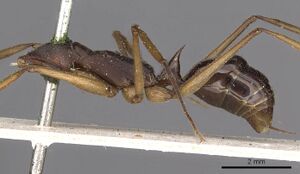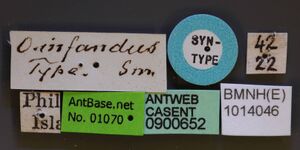Odontomachus infandus
| Odontomachus infandus | |
|---|---|

| |
| Scientific classification | |
| Kingdom: | Animalia |
| Phylum: | Arthropoda |
| Class: | Insecta |
| Order: | Hymenoptera |
| Family: | Formicidae |
| Subfamily: | Ponerinae |
| Tribe: | Ponerini |
| Genus: | Odontomachus |
| Species: | O. infandus |
| Binomial name | |
| Odontomachus infandus Smith, F., 1858 | |
| Synonyms | |
| |
Odontomachus infandus inhabits a wide range of forest habitats, from lowland dipterocarp forests to secondary pine forests at high elevations. It was also found in relatively small forest patches, but never in open land. Humidity and shade at nest sites are likely its main requirements. (Sorger & Zettel 2011)
Identification
Sorger & Zettel (2011) - A member of the Odontomachus infandus group. The following characteristics distinguish O. infandus from other species from Luzon, Odontomachus banksi and Odontomachus schoedli: dorsum of head fully (or almost fully) striate; striation of pronotum predominantly longitudinal, apical of petiolar spine distinctly curved backwards; pilosity of head and mesosoma sparse. See also comparative notes for O. banksi, O. schoedli sp.n. and O. sp. 1 from Camarines.
Odontomachus infandus has a wide distribution on Luzon and Mindoro, and expresses some variation in colour. We have studied a large series from Laguna (Mt. Makiling at Los Baños) which represents the most typical form of this species. Its mesosoma, petiole, and gaster are dark to blackish brown; the head is lighter, usually medium-brown. Other material from Central Luzon (provinces of Cavite and Batangas) agrees well with the Laguna form (the Cavite specimens being slightly more blackish); the same is true for specimens from nearby Mindoro Island. From northern Luzon we have only seen a few specimens which show a rather strong variability in colour. Southward, the material is also heterogeneous. A series from Quezon Province agrees very well with the typical form except that it has a lighter (brownish orange) head. However, the southernmost population (from Albay) is, again, very close to the typical form from Central Luzon
Keys including this Species
- Key to Odonotomachus of the Indo-Australian Region
- Key to Odontomachus infandus species group
- Key to Philippine Odontomachus
Distribution
Endemic to the Philippines; widely distributed from northern to southern Luzon and also recorded from eastern Mindoro. (Sorger & Zettel 2011)
Latitudinal Distribution Pattern
Latitudinal Range: 14.73333359° to 6.734778°.
| North Temperate |
North Subtropical |
Tropical | South Subtropical |
South Temperate |
- Source: AntMaps
Distribution based on Regional Taxon Lists
Indo-Australian Region: New Guinea, Philippines (type locality).
Distribution based on AntMaps
Distribution based on AntWeb specimens
Check data from AntWeb
Countries Occupied
| Number of countries occupied by this species based on AntWiki Regional Taxon Lists. In general, fewer countries occupied indicates a narrower range, while more countries indicates a more widespread species. |

|
Estimated Abundance
| Relative abundance based on number of AntMaps records per species (this species within the purple bar). Fewer records (to the left) indicates a less abundant/encountered species while more records (to the right) indicates more abundant/encountered species. |

|
Biology
Castes
   
| |
| . | Owned by Museum of Comparative Zoology. |
Images from AntWeb
  
| |
| Specimen code casent0900652. . | |
Nomenclature
The following information is derived from Barry Bolton's Online Catalogue of the Ants of the World.
- infandus. Odontomachus infandus Smith, F. 1858b: 81 (w.) PHILIPPINES (no island nominated).
- Type-material: lectotype worker (head missing) (by designation of Sorger & Zettel, 2011: 149).
- [Note: a second possible syntype in BMNH bears the data “Phil. Islds. 48/60”.]
- Type-locality: Philippines “Phil. Isla” (no further data).
- Type-depository: BMNH.
- Sorger & Zettel, 2011: 150 (q.)
- Status as species: Roger, 1861a: 28; Mayr, 1862: 711; Roger, 1863b: 22; Mayr, 1863: 437; Mayr, 1865: 64; Smith, F. 1871a: 319; Emery, 1892d: 561 (in key); Dalla Torre, 1893: 51; Emery, 1893g: 262; Wheeler, W.M. 1909d: 339; Forel, 1910d: 122; Emery, 1911d: 114; Viehmeyer, 1916b: 284; Wheeler, W.M. & Chapman, 1925: 71; Chapman & Capco, 1951: 43; Baltazar, 1966: 239; Brown, 1976a: 104, 125; Bolton, 1995b: 296; Sorger & Zettel, 2011: 149 (redescription).
- Senior synonym of striaticeps: Brown, 1976a: 104; Bolton, 1995b: 296; Sorger & Zettel, 2011: 149.
- Distribution: Philippines (Luzon, Mindoro).
- striaticeps. Odontomachus infandus r. striaticeps Stitz, 1925: 117 (w.) PHILIPPINES (Luzon I.).
- Type-material: lectotype worker (by designation of Sorger & Zettel, 2011: 149), 2 paralectotype workers.
- Type-locality: lectotype Philippines: Manila (Escholtz) (by restriction of Sorger & Zettel, 2011: 149); paralectotypes with same data.
- [Note: originally 5 syntype workers: 3 Manila (Escholtz), 1Manila (Boettcher), and 1 Los Baños (Boettcher).]
- Type-depository: MNHU.
- Subspecies of infandus: Chapman & Capco, 1951: 43; Baltazar, 1966: 239.
- Junior synonym of infandus: Brown, 1976a: 104; Bolton, 1995b: 297; Sorger & Zettel, 2011: 149.
Unless otherwise noted the text for the remainder of this section is reported from the publication that includes the original description.
Description
Worker
Sorger & Zettel (2011) - Lectotype of O. infandus (Note: Head missing): PnW 1.48, PtH 1.37, PtL 0.82, PtW 0.55. Lectotype of O. striaticeps: CI 70, HL 3.20, HW 2.25, MdI 58, MdL 1.85, MsL (not visible), PnW 1.40, PtH 1.30, PtL 1.50, PtW 0.55, SI 140, SL 3.15, TL 16.57. Paralectotype 1 of O. striaticeps: CI 70, HL 3.15, HW 2.20, MdI 57, MdL 1.80, MsL 4.55, PnW 1.38, PtH 1.22, PtL 1.47, PtW 0.53, SI 143, SL 3.15, TL 16.43. Paralectotype 2 of O. striaticeps (Note: Gaster missing.): CI 70, HL 3.28, HW 2.30, MdI 55, MdL 1.80, MsL 4.60, PnW 1.53, PtH 1.37, PtL 1.50, PtW 0.57, SI 142, SL 3.28.
Worker with smallest HW: CI 68, HL 2.68, HW 1.82, MdI 58, MdL 1.57, MsL 3.80, PnW 1.10, PtH 1.17, PtL 1.18, PtW 0.42, SI 152, SL 2.77, TL 12.00; worker with largest HW: CI 73, HL 3.47, HW 2.53, MdI 52, MdL 1.82, MsL 4.87, PnW 1.52, PtH 1.45, PtL 1.60, PtW 0.59, SI 138, SL 3.50, TL 16.31.
Structures: Head striate, striation reaching occipital margin. Pronotum with longitudinally (oval) oriented striation; loops and closed circles may occur in dorsal view. Mesopleuron with fine transverse striation. Short petiolar spine, S-shaped, tilted backwards (how strong differs considerably; usually, the spine is less developed and less curved in smaller workers).
Pilosity: Pubescence dense, short.
Colour: Generally a dark coloured species, but regional variations do occur (see Notes below). Head usually somewhat lighter than mesosoma.
Queen
Sorger & Zettel (2011) - Gyne with smallest HW: CI 75, HL 3.33, HW 2.50, MdI 56, MdL 1.87, MsL 4.73, SI 129, SL 3.22, PnW 1.78, PtH 1.58, PtL 1.62, PtW 0.71, TL 15.50; gyne with largest HW: CI 75, HL 3.37, HW 2.53, MdI 58, MdL 1.97, MsL 4.87, PnW 1.82, PtH 1.66, PtL 1.66, PtW 0.74, SI 129, SL 3.27, TL 16.13.
Compared with worker, striation of mesopleuron reduced, medially either faded or even with small smooth area.
Colour: Head, mesonotum, scutellum, and metanotum variable, medium to light brown, contrasting with other, dark brown body parts. Mesopleuron, petiole, and gaster slightly lighter.
Type Material
Sorger & Zettel (2011) - Lectotype of O. infandus (by present designation, worker, The Natural History Museum) labelled “Phil Isla”, “O. infandus Type. Sm.”, “Syntype”, head missing, characters and type locality corresponding to original description. Note: A second worker labelled “Phil. Islds”, “infandus F. Smith almost certainly a SYNTYPE” is present at BMNH and might be a paralectotype.
Lectotype of O. striaticeps (by present designation, worker, Berlin Museum für Naturkunde der Humboldt-Universität) labelled “Manila. Escholtz.”, “Odontomach. infandus Sm. striaticeps Stz.”, “7156”, “Type”, “GBIF-D FoCol 1062 specimen + label data documented”, “LECTOTYPUS Odontomachus infandus r. striaticeps STITZ, 1925 des. Sorger & Zettel 2010”, “Odontomachus infandus SMITH, 1858 det. Sorger & Zettel 2010” and two paralectotypes of striaticeps (workers, MNHU; pronotum crushed in paralectotype 1, gaster missing in paralectotype 2).
The lectotype of Odontomachus infandus at BMNH is in poor condition but agrees well with the current interpretation of this taxon.
Smith Types
The following notes on F. Smith type specimens have been provided by Barry Bolton (details):
Odontomachus infandus
Two worker syntypes in The Natural History Museum. One is labelled, “Phil. Isla.” and “O. infandus Sm. Type.” The other has, “Phil. Islds. 48/60.” Acc. Reg.: “1848 no. 60. Hong Kong and Philippine Islds. Presented by J.C. Bowring, esq.”
References
- Brown, W. L., Jr. 1976c. Contributions toward a reclassification of the Formicidae. Part VI. Ponerinae, tribe Ponerini, subtribe Odontomachiti. Section A. Introduction, subtribal characters. Genus Odontomachus. Stud. Entomol. 19:67-171. (page 104, Senior synonym of philippinus and striaticeps)
- Satria, R. 2017. Taxonomy of the ant genus Odontomachus (Hymenoptera: Formicidae: Ponerinae) in the Indo-Chinese and Indo-Malayan subregions. Ph.D. thesis, Tokyo Metropolitan University.
- Smith, F. 1858b. Catalogue of hymenopterous insects in the collection of the British Museum. Part VI. Formicidae. London: British Museum, 216 pp. (page 81, worker described)
- Sorger, D.M. and H. Zettel. 2011. On the ants (Hymenoptera: Formicidae) of the Philippine Islands: V. The genus Odontomachus LATREILLE, 1804. Myrmecological News. 14:141-163.
References based on Global Ant Biodiversity Informatics
- Brown W. L., Jr. 1976. Contributions toward a reclassification of the Formicidae. Part VI. Ponerinae, tribe Ponerini, subtribe Odontomachiti. Section A. Introduction, subtribal characters. Genus Odontomachus. Stud. Entomol. 19: 67-171.
- CSIRO Collection
- Chapman, J. W., and Capco, S. R. 1951. Check list of the ants (Hymenoptera: Formicidae) of Asia. Monogr. Inst. Sci. Technol. Manila 1: 1-327
- Janda M., G. D. Alpert, M. L. Borowiec, E. P. Economo, P. Klimes, E. Sarnat, and S. O. Shattuck. 2011. Cheklist of ants described and recorded from New Guinea and associated islands. Available on http://www.newguineants.org/. Accessed on 24th Feb. 2011.
- Sorger, D.M. and H. Zettel. 2011. On the ants (Hymenoptera: Formicidae) of the Philippine Islands: V. The genus Odontomachus LATREILLE, 1804. Myrmecological News. 14:141-163.
- Stitz H. 1925. Ameisen von den Philippinen, den malayischen und ozeanischen Inseln. Sitzungsberichte der Gesellschaft Naturforschender Freunde zu Berlin 1923: 110-136.
- Wheeler W. M. 1909. Ants of Formosa and the Philippines. Bulletin of the American Museum of Natural History 26: 333-345.

